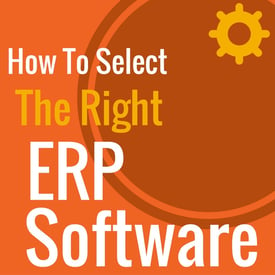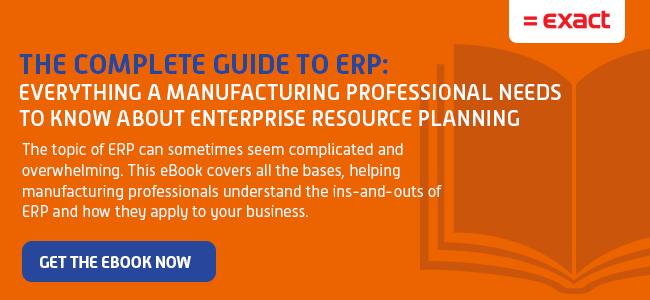Tips for getting ERP right the first time - or how to fix it if you think you got it wrong.
You already know that manufacturers can benefit significantly from using ERP software. However, not all ERP solutions were created equally and an ERP solution that’s a perfect match for one manufacturing company may not be a good fit for another. It is important to give careful consideration to both the selection of the software itself, and to the vendor as well.

Whether your company currently uses spreadsheets and you want to implement your first ERP system, or the ERP system you currently have no longer meets your needs, you’re undoubtedly performing your due diligence… downloading brochures and reading article upon article on how to select a (new) system as well as evaluating the websites and materials of a number of different vendors.The implementation phase is the crucial transition period that takes you from the initial purchase of your ERP software to the point where you fully incorporate it throughout all departments and utilize it across your organization. To maximize benefits and minimize disruption, your ERP implementation needs to be thoroughly planned with a great deal of care, and commitment to the project needs to be consistent across the entire organization.
This is as it should be. Implementing an ERP system is no small matter, and it can be a dizzying exercise. Consultant materials will provide advice, of course, but they often contain all sorts of statistics about failure and over-budget rates that can be paralyzing. This is understandable. They want you to believe you couldn’t possibly succeed without their services and, for some companies, this might be true.
Then you have the glowing descriptions provided by the vendors. The features and benefits described can be hard to tell apart, and their systems seem to do everything but make coffee. The truth is, most ERP systems are alike—on the surface anyway. But as the renowned architect Mies van der Rohe said, “God is in the details.” Figuring out the details will ensure that you get ERP right the first time -- or figure out where you went wrong.
Be clear about why you want an ERP system.
In general terms, most companies envision improved performance and reduced costs. If you’re moving from a spreadsheet environment, you probably want to reduce redundant data entry and possibly reduce manpower. If you already have a system, it may not scale to your company’s growth. Or you may have focused solely on inventory when it was implemented, whereas now you need integration with engineering change orders (ECOs) and/or customer relationship management (CRM) and supply chain management (SCM). You may even need more sophisticated functionality altogether. Whatever your specific reasons, the basic expectation is that by pulling all your business functions into one system, you’ll achieve greater accuracy and streamlined process flows. And with a single database to mine for all reports and analyses, changes in processes, market information, and so forth, your decision-making process will be streamlined as well.
Differentiating Process Problems from Software Problems
Knowing the difference between process and software problems might seem simple, but consider the following real-life examples:
Process Problem: A food manufacturer needed 500 lbs. of flour to make one of its products. The flour came in 550-lb bags. When the workers had poured 500 lbs. of flour into the vat, they tossed the bag with the remaining 50 lbs. off to the side, where it landed in among the spices… a place no one ever thought to look for it. This process problem, of course, resulted in apparent shortages and cost overages that seemed to stem from software problems.
Software Problem: This same company had all its recipes programmed into Excel. Somehow or other, the measurement for spices was changed from ounces to grams. No need to describe the catastrophic results.
The moral of this story: Be sure you know what’s broken before you try to fix it.
Support for Your Differentiators in the Marketplace
This is incredibly important and often overlooked. Here are a few examples of what to think about.
If you’re known for:
- Shipping faster than your competitors
- Low prices
- Responding effectively to customization or unique systems
- Short lead times
- Controlled lead times
- Configuring product lines
Losing your competitive edge shouldn’t be a trade-off.
Modularity, Scalability and Integration
Many systems offer hundreds, if not thousands, of features… most of which you won’t need. This is especially true if you’re embarking on your first ERP implementation.
Don’t be dazzled. The key issues are whether a system:
- Does what you need it to do now, without your having to implement any more than the necessary functionality.
- Has the capability to grow and change as your needs do. This should include APIs for writing integrations for, say, a current or proposed CRM or SCM system.
With that in mind, there is a key factor not to be overlooked: No system will be a perfect match for what you’re looking for. For example, you may have found one that does everything you need it to but doesn’t work with your current financial package. Could you have it customized? Of course. But the implementation would be much more expensive and, down the road, you could potentially run into problems with both support and upgrades. So what makes more sense? Customizing or simply migrating to a compatible financial package? These are issues you have to weigh for yourself.
Vendor Selection
In the context of change management, it was mentioned that one of the biggest reasons ERP projects fail has to do with people, not technology. This is especially true when it comes to selecting a vendor.
A little-known secret is that many companies that are desperate to replace their current system are actually having vendor, not software, problems. Perhaps with a few simple customizations or upgrades—or even just training on features they already paid for but have never used—their system may, in fact, be adequate to meet their needs. But lacking continued guidance and support from the vendor, they haven’t a clue. So what should you look for in a vendor?
Experience with Manufacturing
First, does the vendor know manufacturing? You might think, Well, of course they do. ”Ain’t necessarily so,” as the song goes. How can this be? Over the past decade or so, there’s been a tremendous push to integrate ERP with financial systems. At this point, most ERPs you’ll find out there have been developed by financial companies with no real understanding of or experience with manufacturing or production. The developers can build a system that runs properly but not necessarily do what’s needed, since they can’t differentiate between what’s important and what’s not important in a manufacturing environment. Here are some ways to separate the manufacturing pros from the pretenders: Ask them if they’ve ever worked in manufacturing (not just selling MRP or ERP software) and for how long? Do they want to walk the grid with you? As you move from area to area on the shop floor, do they understand what they’re looking at? Do they ask meaningful and relevant questions? Or do they sit in the conference room with you, talking features and benefits from a PowerPoint presentation and filling in forms?
Experience with Your Specific Product(s) and Manufacturing Methods
The fact that a vendor has been around forever doesn’t mean they offer what you need or that they can intelligently partner with you. What kind(s) of manufacturing do they specialize in? Who are their customers? Does the number or percentage of customers with products and methods similar to yours equate to “experience?”
Support
The overriding question is: Will they be there when you need them? Not just during implementation, but afterward. How accessible are they once the project is “finished?” And when is the project finished? When the software is installed? When it goes live? When all your staff is trained? When you know it’s working properly? In general, do they offer the customer care you need and want?
Besides asking the vendor specific questions about what their ongoing responsibility is to you, ask to speak with current customers whose business is similar to yours. The vendor will, of course, give you only the names of those who are satisfied, but canny questioning can reveal a lot more than you may at first think. Even asking the simple question, “Do you feel as if they had (or have) your best interests at heart?” can be very telling. (Of course, if a vendor won’t give you specific people to call, just move on to the next name on your list of partners.)
The process of selecting an ERP solution should not be rushed or taken lightly. Hopefully these items have provided you with a few items you might not have originally thought of when selecting an ERP system.






